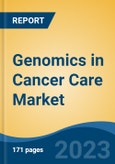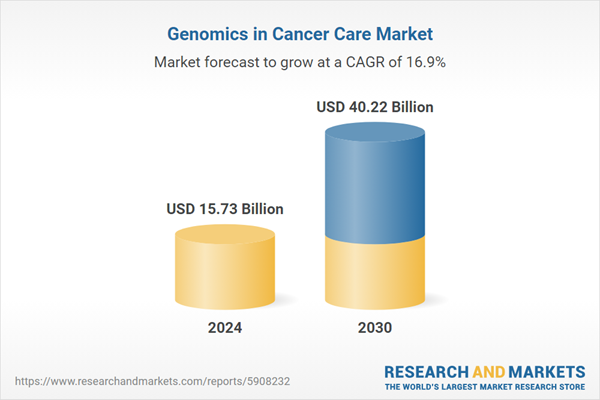Free Webex Call
Global Genomics in Cancer Care Market was valued at USD 15.73 Billion in 2024 and is expected to reach USD 40.22 Billion in the forecast period with a CAGR of 16.91% through 2030. The Global Genomics in Cancer Care Market is experiencing significant growth due to the increasing adoption of precision medicine and advancements in genomic technologies. The integration of next-generation sequencing (NGS), liquid biopsy, and artificial intelligence in cancer diagnostics and treatment has transformed oncology care. Rising cancer prevalence and the growing need for personalized therapies have accelerated the demand for genomic-based solutions. Pharmaceutical companies, research institutions, and diagnostic firms are collaborating to develop biomarker-driven cancer therapies, enhancing treatment efficacy and patient outcomes. The continuous evolution of genomic data analysis tools and bioinformatics platforms further supports the market’s expansion, making genomics an essential component of modern cancer care. Speak directly to the analyst to clarify any post sales queries you may have.
10% Free customizationThis report comes with 10% free customization, enabling you to add data that meets your specific business needs.
Key Market Drivers
Advancements in Genomic Sequencing
In the ever-evolving landscape of cancer care, genomic sequencing has emerged as a potent tool, significantly shaping the Global Genomics in Cancer Care Market. Advancements in genomic sequencing, particularly Next-Generation Sequencing (NGS), have enabled comprehensive molecular profiling of cancer. This allows researchers and healthcare providers to analyze a patient's entire genome to identify mutations, alterations, and genetic markers associated with cancer, facilitating more accurate diagnoses and tailored treatment strategies.The Cancer Genome Atlas (TCGA), a landmark program by the National Cancer Institute (NCI), has molecularly characterized over 20,000 primary cancer and matched normal samples across 33 cancer types. This extensive dataset, comprising more than two petabytes of genomic data, is publicly available and aids the cancer research community in improving prevention, diagnosis, and treatment strategies.
Genomic sequencing allows for the identification of specific genetic mutations driving a patient's cancer, which is invaluable in developing targeted therapies. Pharmaceutical companies leverage genomic insights to create drugs that precisely target the genetic abnormalities responsible for cancer growth, increasing treatment effectiveness and reducing side effects.
Personalized medicine, based on genomic sequencing, has revolutionized cancer care. By analyzing a patient's genetic makeup, oncologists can tailor treatment plans to the individual, optimizing therapy selection and dosage. This approach not only improves patient outcomes but also enhances the overall quality of life during treatment.
Genomic sequencing also plays a crucial role in early detection and prevention. Genetic testing can identify individuals with a higher risk of developing certain cancers, enabling early interventions and proactive health management. Additionally, screening for genetic markers associated with cancer allows for earlier diagnosis and intervention, increasing the chances of successful treatment.
The wealth of data generated through genomic sequencing is a goldmine for researchers and healthcare providers. Advanced data analytics and bioinformatics tools are employed to interpret and extract meaningful insights from genomic data, leading to more informed clinical decisions and supporting ongoing research into new cancer therapies and diagnostic tools.
Advancements in genomic sequencing have driven down the cost of sequencing, making it more accessible for patients and healthcare providers. As sequencing becomes more affordable, its adoption in clinical settings becomes more widespread, further fueling market growth.
In summary, the integration of genomic sequencing into cancer care has transformed the approach to diagnosis, treatment, and prevention, driving significant advancements in the Global Genomics in Cancer Care Market.
Key Market Challenges
Cost and Accessibility
The high cost of genomic technologies and limited accessibility to advanced cancer care remain significant challenges in the Global Genomics in Cancer Care Market. Next-generation sequencing (NGS), whole genome sequencing, and other genomic profiling techniques require expensive instruments, reagents, and bioinformatics infrastructure, making them unaffordable for many healthcare providers and patients. The cost burden is further exacerbated by the need for specialized expertise to interpret complex genomic data, increasing operational expenses for diagnostic laboratories and hospitals. Many low- and middle-income countries struggle to integrate genomic-based cancer diagnostics into their healthcare systems due to budget constraints and the lack of reimbursement policies for these advanced tests.Limited accessibility to genomic cancer care is another critical issue, particularly in remote and underserved regions. Many healthcare facilities lack the necessary infrastructure to conduct in-house genomic testing, leading to delays in diagnosis and treatment initiation. Patients in such areas often need to travel long distances to access specialized centers, increasing financial and logistical burdens. The disparity in access to genomic testing is also evident within high-income countries, where only major medical centers offer comprehensive genomic profiling, while smaller hospitals and clinics face resource limitations. The absence of standardized regulations and inconsistent reimbursement policies across different regions further hinder the widespread adoption of genomic technologies in oncology.
Key Market Trends
Liquid Biopsies and Early Detection
The Global Genomics in Cancer Care Market is experiencing a significant shift toward liquid biopsies and early detection, driven by advancements in next-generation sequencing (NGS) and circulating tumor DNA (ctDNA) analysis. Liquid biopsy is emerging as a revolutionary tool for non-invasive cancer diagnostics, enabling real-time monitoring of tumor progression and treatment response. Traditional tissue biopsies are often invasive, time-consuming, and limited in capturing tumor heterogeneity. Liquid biopsies, on the other hand, provide a comprehensive genomic profile by detecting genetic alterations in circulating biomarkers such as ctDNA, circulating tumor cells (CTCs), and extracellular vesicles in blood samples. The increasing adoption of this technology is improving early cancer detection rates, enhancing treatment personalization, and reducing the need for repeated invasive procedures.Key Market Players
- Illumina Inc
- Agilent Technologies, Inc.
- Roche Diagnostics
- Cancer Genetics, Inc.
- Bio-Rad Laboratories Inc
- Sigma-Aldrich Corp
- QIAGEN NV
- GE Healthcare Inc
- Life Technologies Corp
- Quest Diagnostics Inc
Report Scope:
In this report, the Global Genomics in Cancer Care Market has been segmented into the following categories, in addition to the industry trends which have also been detailed below:Genomics in Cancer Care Market, By Product:
- Instruments
- Consumables
- Services
Genomics in Cancer Care Market, By Technology:
- Genome Sequencing
- PCR
- Microarray
- Nucleic Acid Extraction and Purification
- Others
Genomics in Cancer Care Market, By Application:
- Diagnostics
- Personalized Medicine
- Drug Discovery & Development
- Research
Genomics in Cancer Care Market, By End User:
- Hospitals
- Research Institutes & Academic Institutes
- Others
Genomics in Cancer Care Market, By Region:
- North America
- United States
- Canada
- Mexico
- Europe
- Germany
- United Kingdom
- France
- Italy
- Spain
- Asia-Pacific
- China
- Japan
- India
- Australia
- South Korea
- South America
- Brazil
- Argentina
- Colombia
- Middle East & Africa
- South Africa
- Saudi Arabia
- UAE
Competitive Landscape
Company Profiles: Detailed analysis of the major companies present in the Global Genomics in Cancer Care Market.Available Customizations:
With the given market data, the publisher offers customizations according to a company's specific needs. The following customization options are available for the report.Company Information
- Detailed analysis and profiling of additional market players (up to five).
This product will be delivered within 1-3 business days.
Table of Contents
1. Product Overview
2. Research Methodology
3. Executive Summary
5. Global Genomics in Cancer Care Market Outlook
6. North America Genomics in Cancer Care Market Outlook
7. Europe Genomics in Cancer Care Market Outlook
8. Asia-Pacific Genomics in Cancer Care Market Outlook
9. South America Genomics in Cancer Care Market Outlook
10. Middle East and Africa Genomics in Cancer Care Market Outlook
11. Market Dynamics
12. Market Trends & Developments
13. Porters Five Forces Analysis
14. Competitive Landscape
Companies Mentioned
- Illumina Inc
- Agilent Technologies, Inc.
- Roche Diagnostics
- Cancer Genetics, Inc.
- Bio-Rad Laboratories Inc
- Sigma-Aldrich Corp
- QIAGEN NV
- GE Healthcare Inc
- Life Technologies Corp
- Quest Diagnostics Inc
Table Information
| Report Attribute | Details |
|---|---|
| No. of Pages | 182 |
| Published | March 2025 |
| Forecast Period | 2024 - 2030 |
| Estimated Market Value ( USD | $ 15.73 Billion |
| Forecasted Market Value ( USD | $ 40.22 Billion |
| Compound Annual Growth Rate | 16.9% |
| Regions Covered | Global |
| No. of Companies Mentioned | 10 |









